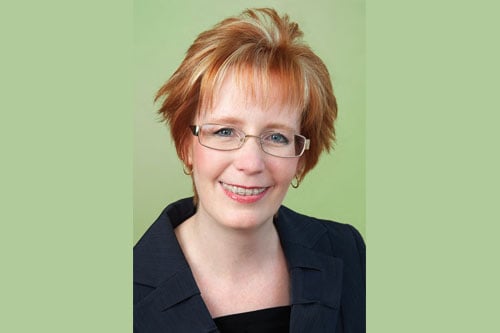Advisor Shelley Johnston wants to see greater definition of what a financial planner offers consumers

Canada’s advisory business is suffering from an image problem – one that Shelley Johnston of the Investment Planning Counsel is all too aware of. It’s keeping fresh blood away from the industry and driving the average age of the profession ever higher. The recent scandal over TD Bank’s unethical sales tactics didn’t exactly help matters, either.
“I have had some people come in since this news broke, and they wanted to know how independent I was,” Johnston says. “They wanted to know if I had quotas for selling products. I can tell them I am fully independent and can sell any product across the board.”
Since 2002, Johnston has been with the IPC, where she specializes in meeting the complex needs of Canadians facing retirement. She started her career with Prudential Insurance in the late ’80s. Working at the firm’s head office for more than a decade, she had regular interaction with advisors, which ultimately paved the way for her current career.
After Prudential was acquired by London Life, Johnston moved to the TD Evergreen brokerage, but the experience isn’t something she looks back on with fondness.
“I threw in the towel one day because I was so disgusted,” she says. “When I see what is in the news now with the banks, I just shake my head because this has been going on for years.”
It’s why Johnston believes there needs to be more distinction about what a financial
advisor actually does. The job in 2017 is a lot more than flogging products, she says, but that’s not something the general public always realizes.
“We need to make what a wealth advisor is and what a financial planner is clearer,” she says. “I am a full-service wealth advisor; I’m not just selling mutual funds. Clients are confused about the different products, the designations and the titles. I am more of a planner, but how we make our money and are compensated is more from the investments and the products we sell. The value-add we bring to the table is the financial and lifestyle planning.”
In the CRM2 era, the cost of financial advice is easier to quantify for clients. Statements now show in dollars and cents how much an advisor is paid, which makes it easier for clients to discern whether the advisor’s performance merits the compensation. At this point, the increased disclosure requirements haven’t had a negative effect on Johnston’s business.
“So far, we have had a really positive
response,” she says. “Not one client has come to me and said I didn’t deserve my fee, but they do want to know what the fund managers are doing for their dollars.”
Johnston shares that curiosity, and she’s currently in the process of overhauling her investment strategy for this year. With a lot more product options out there, there’s no good reason to stick with underperforming mutual funds, she explains.
“Last year I think some of the Canadian fund managers missed the mark on the Canadian market,” she says. “Typically we have been a traditional mutual fund shop with some stocks, bonds and ETFs, but I’m really looking at changing my product shelf and evolving how we invest our clients’ money going forward.”
Johnston doesn’t want to rush this process – rather, she plans to take stock of the current market and decide how her clients’ needs are best served. Central to that is the idea of value – maximizing returns for the fees paid. Just as advisors are now being held to a higher standard of transparency, Johnston would like to see similar moves by the manufacturers.
“I’m not interested in using a flavour-of-the-month fund; we have a strict rule in the office that wholesalers cannot come
in unless invited,” she says. “If I want to use a product, I will contact the individual companies if I want to know more. What I am finding out so far is that some are not being upfront about their fees.”
“I have had some people come in since this news broke, and they wanted to know how independent I was,” Johnston says. “They wanted to know if I had quotas for selling products. I can tell them I am fully independent and can sell any product across the board.”
Since 2002, Johnston has been with the IPC, where she specializes in meeting the complex needs of Canadians facing retirement. She started her career with Prudential Insurance in the late ’80s. Working at the firm’s head office for more than a decade, she had regular interaction with advisors, which ultimately paved the way for her current career.
After Prudential was acquired by London Life, Johnston moved to the TD Evergreen brokerage, but the experience isn’t something she looks back on with fondness.
“I threw in the towel one day because I was so disgusted,” she says. “When I see what is in the news now with the banks, I just shake my head because this has been going on for years.”
It’s why Johnston believes there needs to be more distinction about what a financial
advisor actually does. The job in 2017 is a lot more than flogging products, she says, but that’s not something the general public always realizes.
“We need to make what a wealth advisor is and what a financial planner is clearer,” she says. “I am a full-service wealth advisor; I’m not just selling mutual funds. Clients are confused about the different products, the designations and the titles. I am more of a planner, but how we make our money and are compensated is more from the investments and the products we sell. The value-add we bring to the table is the financial and lifestyle planning.”
In the CRM2 era, the cost of financial advice is easier to quantify for clients. Statements now show in dollars and cents how much an advisor is paid, which makes it easier for clients to discern whether the advisor’s performance merits the compensation. At this point, the increased disclosure requirements haven’t had a negative effect on Johnston’s business.
“So far, we have had a really positive
response,” she says. “Not one client has come to me and said I didn’t deserve my fee, but they do want to know what the fund managers are doing for their dollars.”
Johnston shares that curiosity, and she’s currently in the process of overhauling her investment strategy for this year. With a lot more product options out there, there’s no good reason to stick with underperforming mutual funds, she explains.
“Last year I think some of the Canadian fund managers missed the mark on the Canadian market,” she says. “Typically we have been a traditional mutual fund shop with some stocks, bonds and ETFs, but I’m really looking at changing my product shelf and evolving how we invest our clients’ money going forward.”
Johnston doesn’t want to rush this process – rather, she plans to take stock of the current market and decide how her clients’ needs are best served. Central to that is the idea of value – maximizing returns for the fees paid. Just as advisors are now being held to a higher standard of transparency, Johnston would like to see similar moves by the manufacturers.
“I’m not interested in using a flavour-of-the-month fund; we have a strict rule in the office that wholesalers cannot come
in unless invited,” she says. “If I want to use a product, I will contact the individual companies if I want to know more. What I am finding out so far is that some are not being upfront about their fees.”



